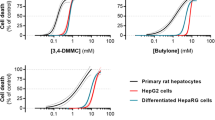Abstract.
The metabolism of 3,4-methylenedioxymethamphetamine (MDMA, ecstasy) has recently been implicated in the mechanisms underlying ecstasy-induced neurotoxicity and hepatotoxicity. However, its potential role in ecstasy-induced kidney toxicity has yet to be investigated. Thus, primary cultures of rat and human renal proximal tubular cells (PTCs) were used to investigate the cytotoxicity induced by MDMA and its metabolites methylenedioxyamphetamine (MDA), α-methyldopamine (α-MeDA), and the glutathione (GSH) conjugates 5-(glutathion-S-yl)-α-MeDA and 2,5-bis(glutathion-S-yl)-α-MeDA. Cell viability was evaluated using the mitochondrial MTT [3-(4,5-dimethylthiazol-2-yl)-2,5-diphenyltetrazolium bromide] assay. MDMA and MDA were not found to be toxic to either rat or human PTCs at any concentration tested (100–800 µM). In contrast, 800 µM α-MeDA caused 60% and 40% cell death in rat and human PTCs, respectively. Conjugation of α-MeDA with GSH resulted in the formation of even more potent nephrotoxicants. Thus, exposure of rat and human PTC monolayers to 400 µM 5-(glutathion-S-yl)-α-MeDA caused approximately 80% and 70% cell death, respectively. 5-(Glutathion-S-yl)-α-MeDA (400 µM) was more toxic than 2,5-bis(glutathion-S-yl)-α-MeDA to rat renal PTCs but equally potent in human renal PTCs. Pre-incubation of rat PTCs with either acivicin, an inhibitor of γ-glutamyl transpeptidase (γ-GT), or bestatin, an inhibitor of aminopeptidase M, resulted in increased toxicity of 5-(glutathion-S-yl)-α-MeDA but had no effect on 2,5-bis(glutathion-S-yl)-α-MeDA-mediated cytotoxicity. The present data provide evidence that metabolism is required for the expression of MDMA-induced renal toxicity in vitro. In addition, metabolism of 5-(glutathion-S-yl)-α-MeDA by γ-GT and aminopeptidase M to the corresponding cystein-S-yl-glycine and/or cystein-S-yl conjugates is likely to be associated with detoxication of this compound. Thus, it appears that toxicity induced by thioether metabolites of ecstasy at the apical membrane of renal proximal tubular cells is the result of extracellular events, presumably redox cycling.
Similar content being viewed by others
Author information
Authors and Affiliations
Additional information
Electronic Publication
Rights and permissions
About this article
Cite this article
Carvalho, M., Hawksworth, G., Milhazes, N. et al. Role of metabolites in MDMA (ecstasy)-induced nephrotoxicity: an in vitro study using rat and human renal proximal tubular cells. Arch Toxicol 76, 581–588 (2002). https://doi.org/10.1007/s00204-002-0381-3
Received:
Accepted:
Issue Date:
DOI: https://doi.org/10.1007/s00204-002-0381-3




